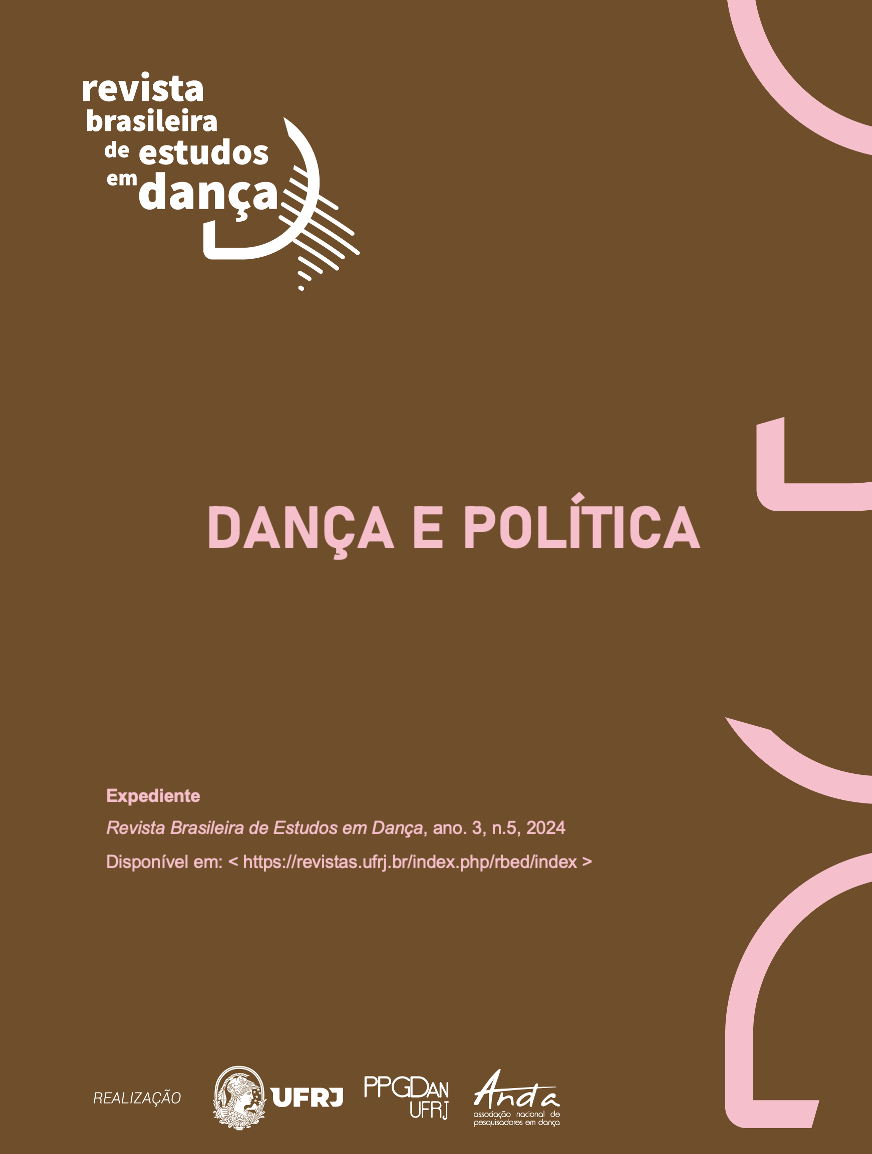Contemporary Studies in dance: mutual relations of cooperation of the bodies on the scene
DOI:
https://doi.org/10.58786/rbed.2024.v3.n5.64202Keywords:
contemporary dance studies, artistic/academic research, body relations in danceAbstract
This article presents cooperation strategies in artistic and pedagogical action in the field of Dance from practice as research. Through a fruitful relationship between critical analyzes of artistic works and pedagogical practice in the Dance Degree course at UFS, different types of
knowledge constructed another investigative and political perspective on the body in the
relationship of dancing with others. Listening to the body in relation to the different bodies (objects and dancers) that constitute the scene is problematized, using as a basis two contemporary dance
works by Grupo Musicanoar (SP). One of the objectives is to identify the communicational,
aesthetic and intentional relationship of performing, but also the unusual friction between a system of actions based on body sciences and contemporary dance studies. The writing of this article is part of a doctoral research carried out in the Postgraduate Program in Performing Arts at USP/SP.
References
ANASTASIOU, L.G.C. Estratégias de Ensinagem. In: ANASTASIOU, L.G.C.; ALVES, L.P. Processos de ensinagem na universidade: pressupostos para as estratégias de trabalho em aula. Joinville: UNIVILLE, 2007.
BASTOS, Helena. Musicanoar, 20 anos: Deslugares? In: Musicanoar, 20 anos: Deslugares? Organização Helena Bastos. São Paulo: Cooperativa Paulista de Dança, 2013.
BASTOS, Helena. “Corpoestados”: singularidades da cognição em dança. Revista Brasileira de Estudos da Presença. Porto Alegre, v.4, n.1,138-147, jan/abr 2014. Disponível em: https://seer.ufrgs.br/index.php/presenca/article/view/37894 Acesso em: 10 set. 2023
BASTOS, Helena. Variâncias: a dança comunicando identidades provisórias. 2003. 142pgs. Tese (Doutorado em Comunicação e Semiótica), Pontifícia Universidade Católica, São Paulo, 2003.
BERTHOZ, Alain. The Brain´s sense of movement. Transl. Giselle Weiss. Cambridge: Harvard University Press, 2000.
BONDÍA, Jorge Larrosa. Tremores - escritos sobre experiência. Belo Horizonte: Autêntica Editora, 2019.
CORIN, Florence. O sentido do movimento. Entrevista com Alain Berthoz. In: Vu du corps. Bruxelas: Contredanse, Nouvelles de Danse, n. 48-49, 2001. Disponível em: https://www.passeidireto.com/arquivo/67446121/berthoh-alain-corin-florence-o-sentido-do-movimento?q=CORIN,%20Florence.%20O%20sentido%20do%20movimento&tipo=1 Acesso em: 12 abr.2023.
GREINER, Christine; KATZ, Helena. Por uma teoria do corpomídia. In: ______. O corpo: pistas para estudos indisciplinares. São Paulo: Annablume, 2005, 125-133.
KATZ, Helena; GREINER, Christine. A natureza cultural do corpo. Lições de Dança 3, Rio de Janeiro: UniverCidade, 1999.
LEPECKI, André. Planos de Composição. In: Cartografia: Rumos Itaú Cultural Dança 2009-2010, Criações e Conexões. GREINER, Christine et al. (Org). São Paulo: Itaú Cultural, p. 13-20, 2010.
LEPECKI, André. Coreopolítica e Coreopolícia. Florianópolis: Ilha, v.13, n.1, p.41-60, jan/jun, 2012. Disponível em: https://periodicos.ufsc.br/index.php/ilha/article/view/2175-8034.2011v13n1-2p41/23932 Acesso em: 10 set. 2023.
LEPECKI, André. Exaurir a Dança: performances e políticas do movimento. São Paulo: Annablume, 2017.
LOPES, Beth. Geometrias inertes, geometrias dançantes. In: corpo e cidade: moveres entre aproximações e distanciamentos. Org. Helena Bastos, São Paulo: Cooperativa Paulista de Dança, 2015, p.29-35.
SPANGHERO, Maíra. O saber da experiência do Musicanoar. In: Musicanoar, 20 anos: Deslugares? Organização Helena Bastos. São Paulo: Cooperativa Paulista de Dança, 2013, p. 45-72.
SEARLE, John R. Consciência e linguagem. São Paulo: Martins Fontes, 2010.
Downloads
Published
How to Cite
Issue
Section
License
Authors who publish in the Revista Brasileira de Estudos em Dança are
responsible for the content of signed articles and retain copyright.
They grant the journal the right of first publication with the work simultaneously
licensed under the Creative Commons Attribution-NonCommercial 4.0 License
(Open Archives Initiative - OAI). This feature, used for open-access journals,
allows sharing work for non-commercial purposes and acknowledges
authorship. If the text is later published in another vehicle, the author
must inform that it was initially published as an article in the Revista Brasileira
de Estudos em Dança. Therefore, even if the journal owns the first publication,
authors are entitled to publish their work in institutional repositories or on
their personal pages, even if the editorial process has not been completed.
The journal reserves the right to make normative, orthographic, and grammatical changes to maintain the language standard, respecting the authorial style.

